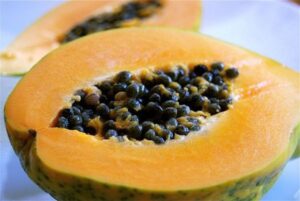Papaya

Contents:
Season for Papaya
Papaya Described
How to Buy and Store Papaya
How to Cook Papaya
Health Benefits of Papaya
Why Buy Natural and Organic Papaya
Season for Papaya Available Year-Round
Papaya Described
For some, papaya need be an acquired taste. For others (like Christopher Columbus who called them the fruit of the angels), the musky undertones simply add to the sweet, buttery deliciousness of this exceptionally healthy tropical fruit. Where papaya was once a rare sighting, you’re bound to find it in every grocery store now, and probably all year long too. Most likely, you’ll come across the Solo variety of papaya grown in Hawaii and Florida that’s large and pear shaped (1-2 lbs) and has a bright yellow skin when fully ripe and juicy, silky flesh – with a distinctively papaya flavor.
How to Buy and Store Papaya
When selecting the perfect papaya, opt for those that are richly colored and give slightly to palm pressure. Ones with patches of yellow or slightly green will ripen in a day or two at room temperature. If you’d like to hasten that process, you can place your papaya in a paper bag with a banana. Really green papayas will never ripen to perfection and should only be bought if you plan to cook them or your recipe calls for them – like a Thai papaya salad. A few black spots are okay, but you probably want to avoid papayas that are bruised or really soft. Refrigerate your fruit as soon as it becomes ripe, and enjoy within a day or two.
How to Cook Papaya
It’s hard to beat the papaya when washed, sliced in half, squeezed over with a wedge of lime, and spooned out into the mouth – yum! But there are other ways to entertain this sunset-colored fruit. The papaya’s cavity is packed with shiny black seeds and while we’d be reticent to simply spoon them into our mouths, these peppery balls are edible indeed and can be added to savory dishes for a crunch and used to make a delicious papaya salad dressing (blended in).
You’ll find the addition of lime or lemon to your papaya brings out its breadth of flavor. Papaya goes beautifully in salsas and Asian-themed salads. Ripe papaya is also good in tropical fruit salads and puréed in smoothies. Use green papaya as a vegetable, or pickle it!
Health Benefits of Papaya
Containing a breadth of vitamins, antioxidants, trace minerals, folates, fiber and more, all the goodness in papayas combines synergistically to reduce the risk of cancer and cardiovascular disease, and all this coming in at just around 50 calories per cup! The fruit, as well as the other parts of the papaya tree, contain papain, an enzyme that helps digest proteins – aiding in digestion in general and the excretion of toxins from the body. Externally, papaya is used in anti-aging products, both the skin and pulp valuable healing agents. It’s rich with enzymes that help uncover a radiant, fresh complexion.
Why Buy Natural and Organic Papaya
Papaya is among the fruit found with the least amount of pesticide residues, so when organic is not available, you may still consider a conventional papaya. Rinse the skin well, however, so that what pesticides there are don’t transfer from the the knife into the flesh you’ll be consuming. Keep in mind, while washing fruits and veggies does help to clean off some of the chemicals, artificial fertilizers can feed the roots of a plant and just as other nutrients do, the chemicals will be dispersed to all parts of the plant. Eating organic is the only way to know you’re only getting the good stuff.
image: love janine

